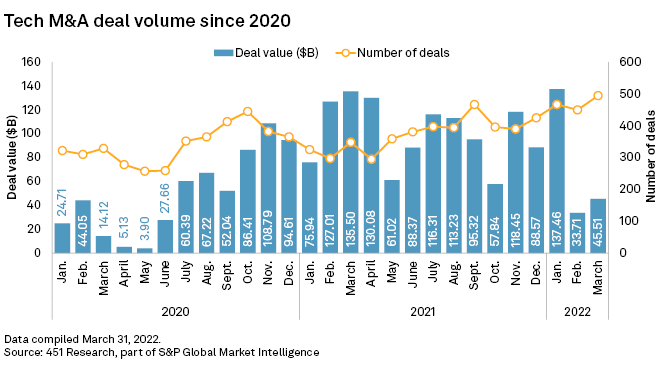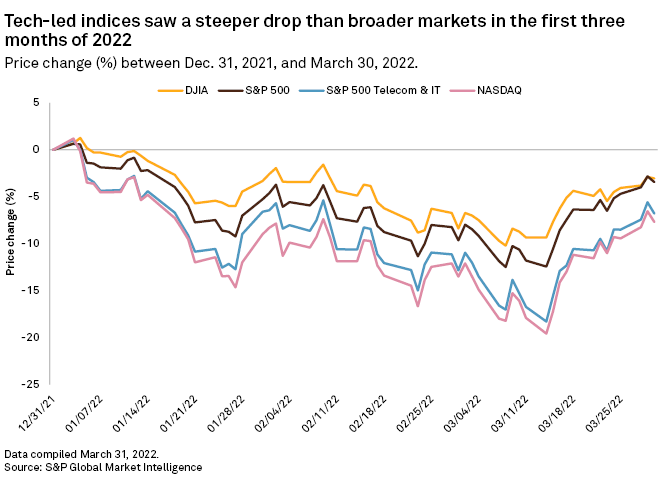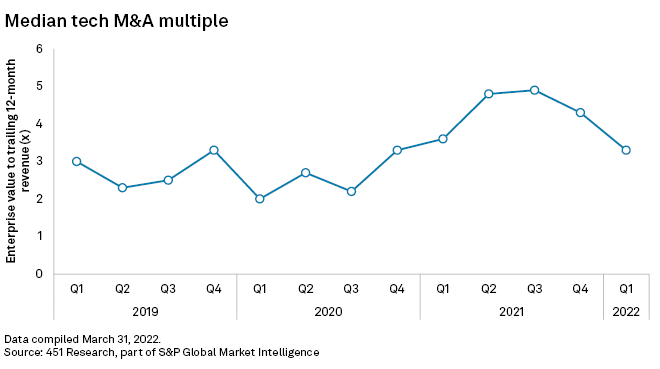Technology M&A values dive in Q1 even as volumes hit record
Technology investors experienced some whiplash in the first quarter as equity values plummeted and acquisition values fell to the lowest totals tracked since the middle of 2020.
After record M&A activity in 2021 that landed the industry above the unprecedented $1 trillion mark, acquirers pumped the brakes in 2022, agreeing to $216.67 billion in transactions in the first quarter. By comparison, the industry saw $338.45 billion in deals in the first quarter of 2021.
However, even if values came down, the pace of deals remained just as robust as the records set in previous quarters. There were 1,412 technology M&A transactions announced in the first quarter, more than any quarter in the 20 years of records for 451 Research.
Analysts believe activity could continue at an elevated pace as acquirers shake off the headwind of higher interest rates and embrace a "buy the dip" mentality in the current discounted market.
"I think some of the big tech companies are going to use the drop in valuations as a buying opportunity," University of Florida finance professor Jay Ritter said.
The heaviest M&A spending during the quarter occurred in January, when total deal values reached $137.46 billion. The strong start to the year was followed by a sharp correction in February and March, when total deal values were $33.71 billion and $45.51 billion, respectively.
Interestingly, while March saw much lower deal values than January, it actually saw more deal volume.

The compressed deal values came as technology equity markets took a sharp turn in the last two months of the quarter. The S&P Technology and Telecom Index spent the month of February in the red, and it bottomed out March 14, off by 18.3% year to date. The index was off by 6.8% at the March 30 close.
"If you're a firm assessing the current environment, thinking about higher interest rates and higher inflation at the same time, you have to reconsider the valuations for deals you make," said Michael Crook, chief investment officer at investment adviser Mill Creek Capital. "I'm not surprised to see a lot of those deals were paused in order to give firms time to assess."
The sharp decline in valuations may have been impacted by inflation and geopolitical concerns, but the primary driver of discounts in the market, particularly in the tech market, is interest rates, Crook said. If unprofitable growth companies are going to pay more in rates on their debt funding, analysts push their future earnings estimates out farther, leading to high discounts on present-day valuations.

Much of the consolidation in the technology industry includes the acquisitions of growth companies, which has led to lower technology M&A valuations than the broader market. However, much of the value adjustments against growth companies may be behind us, Crook said.
"The disparity between growth and value is probably played out. We have some parts of the market that are down 50% while the broad equity market is down 4%, or even up depending on the time horizon," the investment adviser said.
The reset in growth valuations has been some time coming, and it could represent a permanent shift in how the market values growth companies, Ritter said.
"After many years of growth outperforming value and the valuations on growth companies getting pushed up to higher and higher levels, there's been a major reset," Ritter said.

However, even with the February correction in growth stocks, valuations are still much higher than they were in the decades leading up to the pandemic. That is also driven by interest rates, real interest rates specifically. Real interest rates reflect not the temporary rate hikes and reductions by the U.S. Federal Reserve, but the cost of borrowing adjusted for inflation. The real interest rate has been getting lower for decades, particularly in the past two years, Ritter said.
"Federal Reserve policy has some effect, but it gets too much attention compared to long-term trends," Ritter said.
451 Research is part of S&P Global Market Intelligence.








Gloss